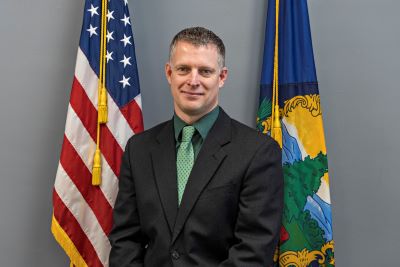Vermont Emergency Management Organizational Chart
Eric Forand, Director

Engagement
Emily Harris, Engagement Section Chief
The Engagement Section supports local planning, training & exercising, statewide training, and school safety. If you are from a local entity and aren't sure who you want to speak with at Vermont Emergency Management, please start with your Regional Coordinator.
Hazard Mitigation
Stephanie Smith, Mitigation Section Chief
The Hazard Mitigation Section supports municipalities, Regional Planning Commissions, and state agencies in applying for and implementing projects under FEMA's Hazard Mitigation Assistance grant programs and state funding. Every five years, the Section develops an update to the State Hazard Mitigation Plan through a robust stakeholder process to develop a path toward a more resilient Vermont. Section staff supports municipalities and Regional Planning Commissions in conducting natural hazard mitigation planning and developing FEMA-approved Local Hazard Mitigation Plans.
Operations and Logistics
Brett LaRose, Operations and Logistics Section Chief
The Operations & Logistics Section administers and manages the networks needed to support local governments and other stakeholders during the response phase of an emergency. This section focuses on sustaining a centralized network for VEM and the State Emergency Operations Center (SEOC) to deliver assistance, notifications, and capabilities to local governments and other stakeholders. The operations and logistics section supports VEM’s communications and logistics missions. This function is paramount to ensuring VEM has an interoperable network with redundancy for emergency communications. The Operations and Logistics Section is responsible for the Watch Officer program, the State’s 24-hour, 365-days-a-year position for emergency incidents, activities, and events within the State of Vermont. The Watch Officer receives notifications from stakeholders and distributes notifications to relevant stakeholders to initiate operational readiness, situational awareness, and emergency coordination actions needed to support emergency incidents, activities, and events within Vermont.
Planning and Preparedness
Max Kennedy, Planning Section Chief
The Planning Section is responsible for writing and maintaining the State Management Plan and associated annexes, including incident-specific plans and annexes for all State Emergency Operations Center (SEOC) partners. As needed, Emergency Management Planners develop new plans and continuously improve existing plans and procedures based on lessons learned from exercises and actual events. The State Exercise Administrator supports state agencies in the planning, developing, and executing Emergency Management exercises using the Homeland Security Exercise and Evaluation Program methodology, ensuring stakeholders are prepared for the next emergency.
Recovery
Vacant, Recovery and Mitigation Section Chief
The Recovery Section supports the State Recovery Officer in activating and coordinating long-term Recovery Support Functions (agriculture, economic recovery, housing, cultural and historic recovery, individual and family needs assistance, and infrastructure). This includes serving as a Recipient of the Public Assistance Program, FEMA's largest funding stream, which delivers federal cost-share support for infrastructure recovery.

